
We are celebrating 15 years — and counting — of stories that are deeply researched and deeply felt, that build a historical record of what the city has been.
We are celebrating 15 years — and counting — of stories that are deeply researched and deeply felt, that build a historical record of what the city has been.
Various recent innovations in secondary education in New York have used the city itself as an organizing theme for curricular experimentation. Urban Assembly schools like the School of Design and Construction or the New York Harbor School focus students’ attention on the built and natural environment around them. Alternative high schools like City-As-School prioritize hands-on work experience through internships in diverse fields. And complementary education programs like the Center for Urban Pedagogy’s City Studies offer project-based curricula for public high school students, in class and after school, that use art and design to analyze and communicate the complexity of urban systems.
But there’s another, older tradition within public high schools that demonstrates how fulfilling our urban policy priorities and reforming our secondary education can be mutually beneficial goals. Career and Technical Education (CTE) has come a long way since its predecessor — vocational-technical schools — prepared students for full-time jobs after graduation, primarily in industrial or agricultural sectors. As those jobs have diminished and the need for a postsecondary education has grown, skills-based learning has reinvented itself to respond to a postindustrial labor market. Below, John Surico takes a closer look at CTE programs in New York City. His investigation chronicles how the reinvention and expansion of CTE aligns with broader urban trends and objectives: diversifying cities’ economies, maintaining national competitiveness, and creating stable middle-class jobs. –C.S.
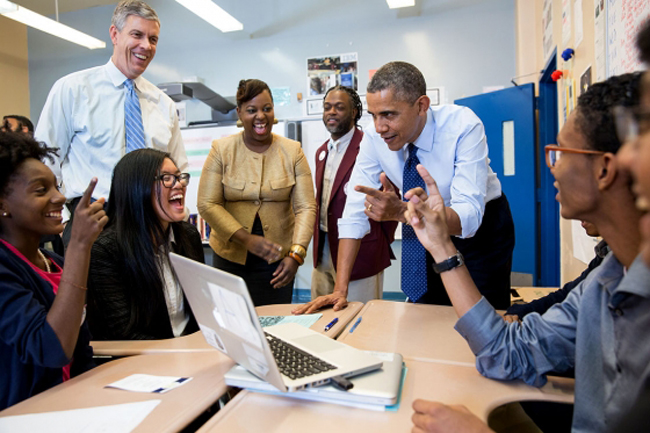
President Barack Obama and Education Secretary Arne Duncan talk with students while visiting a classroom at the Pathways in Technology Early College High School (P-TECH) in Brooklyn, NY, Oct. 25, 2013 | Official White House Photo by Pete Souza
“When I was living here, Brooklyn was cool,” President Barack Obama, a former Park Slope denizen, told a packed auditorium of students, teachers, and elected officials this past October. “But not this cool.”
Obama had just finished up his tour of P-TECH, short for Pathways in Technology Early College High School. He had mentioned the public school on Albany Avenue in Crown Heights as an example in his State of the Union address months earlier, lauding the school’s six-year associate degree program and partnership with IBM, which offers students entry level positions after graduation. Now, he had the chance to pop his head in and surprise the classrooms of note, test out projects like the “Earthquake Tower Challenge,” and ask students if mathematics was actually always a passion.
“No,” the students responded to much laughter, but the answer to Obama’s question suggests his reason for being there: after years when public school curricula have prioritized traditional subject matter, CTE was effectively “cool” again. And nowhere is this more apparent than in New York City.
CTE, which stands for Career and Technical Education, is a pedagogical model that uses the study of industry skills to complement textbooks and tests. Students can get local, hands-on experience in sectors such as film, healthcare, software, engineering, and numerous other fields. CTE schools supplement the arts and sciences curricula of traditional secondary education by offering skills-based courses instead of electives. In theory, these options will better prepare students for the complex and rapidly changing job market they face.
The fields found underneath the CTE umbrella vary. Some schools offer a wide variety of technical training: students at the School of Cooperative Technical Education in Manhattan can take classes in everything from automotive technician training to culinary arts. Others are more specialized, like the Bronx Academy for Software Engineering. And a particular subset of this growing education trend connects to the built environment by using the city as the classroom to teach. This idea is central to those programs geared towards traditional careers in design and construction, like the City Polytechnic High School of Engineering, Architecture, and Technology in Brooklyn, where students can study architectural drafting and civil engineering. But urbanism also plays a role in the technology-focused programs at P-TECH or In-Tech Academy in Brooklyn. In this expanded understanding of classroom urbanism, the tech industry’s potential to create jobs in New York — an initiative that has been heralded in City Hall — moves beyond just software and apps. IBM’s investment in the P-TECH partnership, for example, coincided with the launch of Smarter Cities, a key component of its Smarter Planet corporate initiative, which is premised on the need for advanced technological systems to optimize city government operations. Thus, the skills learned in these schools can be applied in the physical fabric of the city itself and integrated into our everyday lives.
In the past, the lessons taught at a school like P-TECH would have been deemed “vocational.” The manufacturing jobs that once provided a steady pathway to middle-class stability without requiring a college degree are dwindling, especially in places like New York City. And vocational secondary education’s modern makeover into CTE has made the model nearly unrecognizable from its predecessor, readjusting education to different realities and a rapidly shifting job market after high school graduation. Both P-TECH and City Polytechnic offer associates degrees (at no cost to students) while also preparing students for four-year colleges. According to Marc Dunetz, the VP of school support of New Visions for Public Schools, a non-profit educational organization, “CTE, in general, runs on the premise that a secondary school can be responsive to the economy.”
Matthew Williams, principal of the Bronx Design and Construction Academy, agrees. “In traditional liberal arts [public] schools, students’ aspirations are ambiguous after four years, [they’re] asking themselves ‘What can I do with this?’” But William’s firm belief in the potential of CTE isn’t limited to job prospects. He considers CTE to be “one of the best ways we know how to teach critical thinking skills.”
https://www.instagram.com/p/gLfck8xnWu/
The Academy, a public high school located in the South Bronx, opened its doors in 2011. It made headlines this February when it received the Zayed Future Energy Prize in the United Arab Emirates, beating out schools across the world to win a $100,000 grant for a student-made blueprint of a greenhouse-like energy center on campus. To step back a minute: a three-year-old school located in what has traditionally been the poorest congressional district in America won an international contest in Abu Dhabi for sustainability.
How? Well, the Bronx Design and Construction Academy’s curriculum revolves around green technology, which, to Principal Williams, is a reaction to where New York City’s construction industry, and economy in general, is headed. “Three years ago, we weren’t teaching sustainable practices; now, all employers want new applicants to have them down pat,” he said. “We want our students to be able to go into a construction industry without worrying about new technologies or feel like they’ve had their head in the clouds.”
In order to do so, sustainability practices are integrated into the school’s five “industry-themed pathways:” electric, plumbing, HVAC, carpentry, and architectural drafting/pre-engineering. The real-world experience is intended to give students an advantage in postsecondary education as well as career opportunities. While also maintaining a liberal arts curriculum, students at the Academy follow a four-year path more comparable to a university than a high school.
In freshman year, students sample each field for two to three weeks; by doing so, they “learn the ecology of them, and sustainability through science,” Williams told me, citing a partnership with Sustainable South Bronx. The local, non-profit organization helped build the school’s rooftop farm, which is used as a classroom for the new students. As sophomores, the students choose one of the five strands, as if picking a major, and begin to learn its basic courses. So, come junior year, the students are ready for area-specific projects, using what the school building has to offer as their paper and pencil: HVAC apprentices fix the kinks in the school’s boilers; budding architects figure out how to maximize its space efficiency; future electricians build solar panels for the roof; carpenters use recycled wood to build new furniture for classrooms; and plumbers construct L.E.E.D.-certified water heaters.
“They’re as excited as we are! It’s cutting edge technology,” Principal Williams said of his students. “Analysis and consuming information are what these kids want to do, especially when it comes to cutting the carbon footprint. There are long-term benefits, ones that last past the next 30 minutes.”
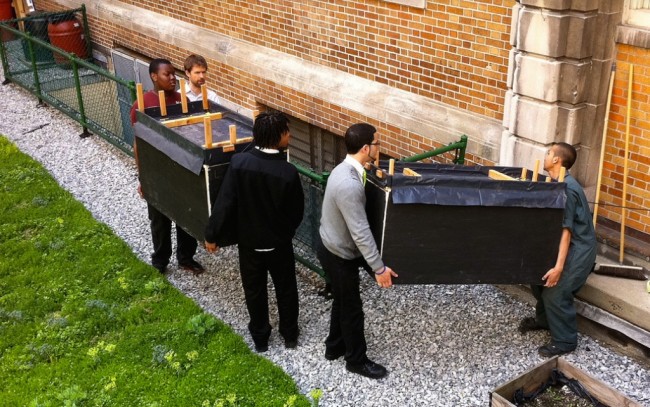
Installing models to test green roof integrated PV canopy systems at Bronx Design and Construction Academy. | Photo by Christina Ho, via Engineering for Change
A common criticism of CTE is that high school freshmen are not old enough to decide their futures: that, by the time they enter high school, these students aren’t ready to decide what they want to be when they grow up. A report by UC Berkeley took this opinion into account, and came to the conclusion that while not all students are ready for CTE, “a curriculum that integrates academic and career-technical education,” if available, provides students with more of a choice rather than focusing too much attention on one specific field, as was done in the past with vocational schooling.
By doing so, students taking CTE courses wouldn’t necessarily be locked into the designated fields; skills like computer science or software engineering would certainly prove useful if they chose to explore other fields. As the NYC Department of Education’s FAQ page states, “Students who graduate from CTE schools have multiple options. They may choose to continue their education at colleges and universities, go directly into the workforce, select technical training programs, apprenticeships, or schools that specialize in their chosen field of interest, or some combination of all of the above.”
Even so, the movement seems to be picking up speed across the country and influencing course offerings at traditional schools in the process. As the US Department of Education’s Office of Vocational and Adult Education said back in 2007, “Virtually every high school student takes at least one career and technical education course, and one in four students takes three or more courses in a single program area.”
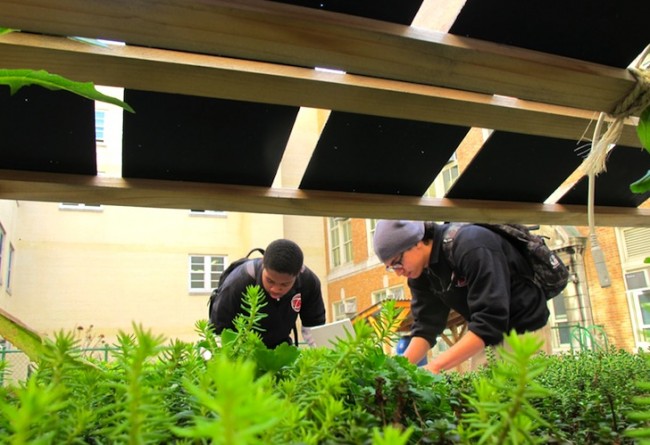
Bronx Design and Construction Academy students take measurements on their award-winning green roof, complete with the photovoltaic panels seen here. | Photo courtesy of Bronx Design and Construction Academy
Just like with Obama at P-TECH, the students’ passions for mathematics and sciences can be surprising to some, especially in a part of New York where over 90 percent of students are reportedly not ready for college-level work come graduation. But, to Principal Williams, the local environment of the South Bronx provides the perfect laboratory for CTE. “It’s easy to show consequences of the lack of sustainability here,” he told me, calling the alarming health statistics in the South Bronx “a motivating tool for change.”
According to a recent report, CTE programs particularly benefit students who enter high school less likely to graduate than their peers, raising graduation rates by nearly ten percentage points for black and Latino students. To Thor Snilsberg, the Executive Director of CityScience, this statistic points to a major formula of CTE’s success in New York City: the number of students living in lower-income neighborhoods who might not otherwise be exposed to emerging technologies.
“Underrepresented minorities in New York City are a huge part of the student population, and the people in these tech jobs now aren’t the underrepresented minorities,” Snilsberg argued. “So there’s an enormous amount of homegrown talent for New York City to tap into.”
CityScience is an organization that seeks “to integrate an understanding of the local built environment into our urban education models” through school and community partnerships. In order to do so, Snilsberg said the organization “uses an integrated approach where history, sociology, and other urban planning considerations are melded with STEM content.”
STEM, an acronym for science, technology, engineering, and mathematics, lies at the center of a nationwide shift to incorporate economic competitiveness into education, as students in superpowers like China and India continue to surpass their American counterparts in academic readiness. While STEM advocacy is not limited to technical education, it does demonstrate that the perception of a skills gap for 21st century Americans is not isolated to poor, “inner-city” neighborhoods. It’s across the board, and CTE reflects this broader trend and advocacy effort.
Most of the work done by CityScience happens after school or outside the typical school calendar, which, according to Snilsberg, allows educators to “combat summer learning loss and extend the learning day.” This way, CityScience works as a complement to CTE schools, holding, in Snilsberg’s view, the “same commitment to inquiry and project-based learning pedagogies.” He cites the example of the Paterson Great Falls Youth Corps, in Paterson, New Jersey, a program that offers students, mostly from immigrant families, lessons in urban forestry, biology, GIS mapping, and the history of Paterson. Then, during the summer, the students work full-time at the park, alongside professionals, on everything from ecological surveys to creating multi-lingual brochures.
“By using the city as an informal resource to teach STEM, students benefit from seeing STEM subjects in context, in their neighborhoods and in real life,” Snilsberg said, echoing Principal Williams’ sentiment. “This education lets the kids give back to the communities they belong to, and gives them a whole new sense of importance.”
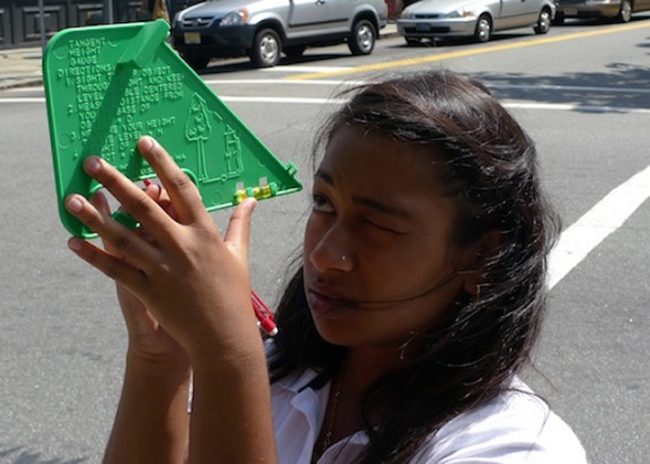
A member of the Great Falls Youth Corps participates in a street tree inventory in Paterson, NJ | Photo via CityScience
CTE in the Bloomberg Years
In terms of sheer numbers, the Bloomberg Era was a Golden Age for CTE — a point President Obama praised the now-former Mayor for in his speech that afternoon at P-TECH. According to former Education Chancellor Dennis Walcott, “In 1960, there were 18 career and technical education schools, then called vocational schools, citywide. In 2002, there were still 18. Today, there are 46.” Now, there are over 140,000 students actively enrolled in CTE programs across the five boroughs.
The business-minded former mayor hailed the schools as job hubs in New York City, training the future generations for what Bloomberg hoped would be the next Silicon Valley. This desire was part of his administration’s larger attempt to diversify the finance-driven economy by providing incentives — like tax breaks and cheaper office space — for tech and manufacturing businesses to locate in New York.
“It was a clear decision — you don’t have that many schools built by accident,” Marc Dunetz pointed out. “It was the general consensus that for schools to have relevance, they need to have more of a connection to the workforce.”
According to Dunetz, the Department of Education did not pay much attention to age-old vocational schools for years, finding little value in what officials construed as dead-end programs. But, as technology became an increasingly important component of the city’s economy over the last decade, CTE as a whole became much more appealing to the agency.
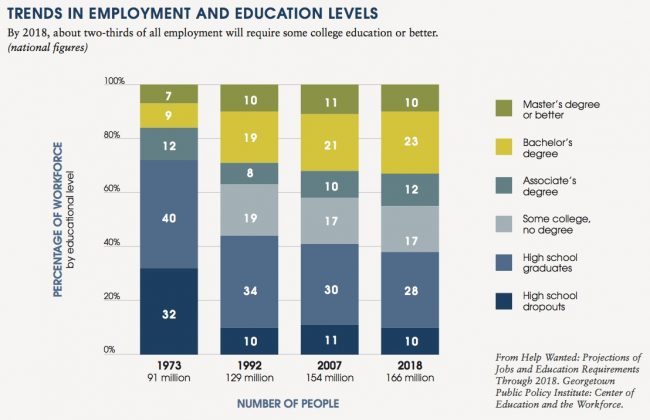
In its 2013-2014 report on the state of CTE in New York City, the Department of Education included this chart showing the increasing need for postsecondary education over time.
In February of 2001, the New York State Board of Regents approved a new policy on CTE, one that worked not as “a mandate, but an option for school districts and BOCES to provide quality CTE programs with flexibility in their delivery.” The policy had a two-step approach to what would later be a Bloomberg staple: upgrade CTE programs to the 21st century, and make it much easier for schools to implement them into the curricula. And this accommodation was met with dollar signs: in 2004, the budget for existing vocational schools was $134 million; by 2007, nearly five years after Bloomberg gained mayoral control of the Department of Education, the budget grew to $216.2 million, most of which came from City funds, as more schools were built.
Then, in his 2008 State of the City address, Mayor Bloomberg convened the Mayoral Task Force on Career and Technical Education Innovation to find out what CTE needed most to improve itself, just as he was making the push for a Silicon Valley-like renovation of New York’s emerging tech industry. Later that year, the group released preliminary recommendations, which called for stronger industry partnerships, higher graduation rates, and an easier transfer of credits amongst programs, using urbanism as a call to arms for the movement. “This vision is echoed across the country in discussions of 21st century skills, global competition and secondary school reform,” the report read.
It’s an educational shift the Department continues to keep a close eye on, releasing the equivalent of a report card each year to update educators on CTE progress in the largest public school system in the country. Officials point to the 18 percent higher likelihood that a student will graduate from a CTE school built after 2003 than a traditional secondary school, and the prediction that 63 percent of the workforce will need a postsecondary education to land a job in 2018. And examples of CTE success are referenced across the city, whether it’s electrical students from Queens Vocational and Technical High School helping Sandy victims rebuild homes, or the first paying client for IAM Advertising, a student-run advertising firm from the High School for Innovation in Advertising and Media.
As Thomas Wilkin, the assistant chair of CTE Teacher Prep at CUNY, explains, two pressures drive CTE in New York: the top-down demand for workers in growing tech fields, as well as the bottom-up demand for education that pays out come graduation day. Wilkin believes “that CTE schools have grown in recent years due to the strong interest of both the corporate world in obtaining highly skilled and talented workers and the desire on the part of students to prepare for a meaningful and profitable career.”
The former highlights the attraction to corporate sponsors in CTE schools, such as P-TECH’s partnership with IBM, something the Department of Education stresses. The third page of the most recent CTE report card is titled “A Message to the Business Community;” written by an IBM VP himself, which articulates the long-term benefits of teaching CTE to prospective students. This partnership is part of the Applied Science NYC initiative set forth by the Bloomberg administration, which seeks to drive larger institutions and ideas to the Big Apple by using urbanism as its calling card. Since established, the Initiative has found success in establishing the Center for Urban Science and Progress at New York University and the forthcoming Cornell Tech on Roosevelt Island. In effect, the pitch is as follows: New York City can be a great place to not only to train the technology innovators of the future, but also to incubate companies and grow the number of jobs in that sector.
The latter objective, however, indicates more than the desire for job creation; it also reflects the next generation’s loss of faith in the traditional college degree’s purchasing power. “Having these academic programs in school is important, but the programs we teach can be life-changing for students,” Dunetz said. “It’s a job track to well-paying industries for students with absolutely no background. They now have a renewed interest in the field.”
To Dunetz — who, prior to his position at New Visions for Public Schools, was Principal of the Academy for Careers in Television and Film in Queens — the strong connection to market forces is what distinguishes specialized schools from other institutions. This real-world tie-in shields CTE from the political noise surrounding topics such as the charter school debate or the closing of underperforming schools. “It’s not so much about developing political support, but logistical and strategic support,” he said. “It’s one of the areas where everyone agrees it has real value.”
The Future of CTE in de Blasio’s New York
As public advocate and mayoral candidate, Bill de Blasio called for reforms in New York City’s CTE schools, promising to expand CTE school construction by building upon the Bloomberg administration’s legacy, as well as to promote interagency cooperation to land graduating students jobs in the competitive job market. His 2012 report cited a serious and longstanding performance gap between CTE and general education schools. 50 percent of the CTE schools the public advocate’s office sampled found themselves on the “Persistently Low-Achieving List” at some point in the past few years. Although this statistic doesn’t necessarily correspond to graduation rates in general, the report also states that a third of New York’s CTE students were enrolled in these suffering schools and were half as likely to enter college than their peers.
To fix this problem, de Blasio called for, and reiterated as mayor, more partnerships like the one established with IBM: programs that would promote job placement after a certain amount of years in high school or college. He also argued that focus was misappropriated on programs that weren’t exactly fit with the future; for example, the arts, A/V, and communication programs might dominate 18 percent of CTE programs, but jobs in these fields will only grow by 2 percent in the next five years.
But, as Principal Williams explained, the disparity should be viewed more as an incentive for CTE schools to break away from the past. “We’re forcing CTE to drive rigor up,” he explained. “For example, you have to have an 80 on your Math Regents to get into our plumbing programs.”
While Bloomberg focused on economic diversification, de Blasio has made strengthening the economic foundations the focus of his policy platform, which shifts the CTE ideology emanating out of City Hall from encouraging Silicon Valley aspirations to retaining middle class job security. All of the people I spoke with agreed: the new mayor is likely to embrace the ascension of CTE in our public schools. And it seems like he already has, emphasizing programs that can produce “high-growth, high wage and high skill jobs.”
But, as we can see, the educational model de Blasio has in front of him runs parallel to the economy. According to the latest projections, New York City is poised to add 423,060 jobs between 2010 and 2020, a solid portion of these coming from fields that correspond to the emphases of existing CTE schools. The movement is now developing at the same speed of de Blasio’s city and doesn’t seem to be falling behind anytime soon.
And that is what lies at the center of this particular trend in secondary education: the idea that our education system can essentially ride the city’s rapidly changing undercurrents of activity, keeping curricula dynamic as the economy diversifies. The applied learning of CTE exemplifies a productive way to use the specific context and resources of New York to meet a variety of goals. By teaching students how to use our urban assets for their own self-development, we’re not only preparing them for the real-world contexts, but also encouraging young people to invest in — and help to shape — their own city’s future.
The views expressed here are those of the authors only and do not reflect the position of The Architectural League of New York.